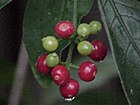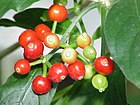Note: This is a project under development. The articles on this wiki are just being initiated and broadly incomplete. You can Help creating new pages.
Difference between revisions of "Cephaelis ipecacuanha"
(→References) |
(→References) |
||
| (7 intermediate revisions by the same user not shown) | |||
| Line 1: | Line 1: | ||
| − | + | [[File:Cephaelis acuminata0.jpg|thumb|right]] | |
| − | + | '''Ipecac''' is a small shrub growing about 50cm tall. The plant has been used medicinally by the native peoples of America for many centuries. | |
==Uses== | ==Uses== | ||
| − | {{Uses|}}, {{Uses|}}, {{Uses|}}, {{Uses|}}, {{Uses|}}, {{Uses|}}, {{Uses| | + | {{Uses|Fevers}}, {{Uses|Dysentery}}, {{Uses|Coughs}}, {{Uses|Bronchitis}}, {{Uses|Whooping cough}}, {{Uses|Vomiting}}, {{Uses|Diarrhoea}}. |
==Parts Used== | ==Parts Used== | ||
| − | + | {{Parts Used|Root}}. | |
==Chemical Composition== | ==Chemical Composition== | ||
| − | <ref name="chemical composition"/> | + | The roots of ipecac contain a number of medically active constituents including isoquinoline alkaloids, tannins and glycosides.<ref name="chemical composition"/> |
==Common names== | ==Common names== | ||
| Line 17: | Line 17: | ||
===Dravya=== | ===Dravya=== | ||
===Rasa=== | ===Rasa=== | ||
| − | |||
===Guna=== | ===Guna=== | ||
| Line 30: | Line 29: | ||
==Habit== | ==Habit== | ||
| − | {{Habit|}} | + | {{Habit|Shrub}} |
==Identification== | ==Identification== | ||
| Line 49: | Line 48: | ||
==Mode of Propagation== | ==Mode of Propagation== | ||
| − | {{Propagation|}} | + | {{Propagation|Seeds}}, {{Propagation|Greenwood cuttings}}, {{Propagation|Root cuttings}}. |
==How to plant/cultivate== | ==How to plant/cultivate== | ||
| − | <ref name="How to plant/cultivate"/> | + | Prefers a minimum temperature in the range of 15 - 18°c.<ref name="How to plant/cultivate"/> |
==Commonly seen growing in areas== | ==Commonly seen growing in areas== | ||
| − | {{Commonly seen| | + | {{Commonly seen|An understory shrub of rainforests}}. |
==Photo Gallery== | ==Photo Gallery== | ||
<gallery class="left" caption="" widths="140px" heights="140px"> | <gallery class="left" caption="" widths="140px" heights="140px"> | ||
| − | + | Cephaelis acuminata0.jpg | |
| + | Cephaelis acuminata1.jpg | ||
| + | Cephaelis acuminata2.jpg | ||
| + | Cephaelis acuminata3.jpg | ||
| + | Cephaelis acuminata4.jpg | ||
</gallery> | </gallery> | ||
| Line 65: | Line 68: | ||
<references> | <references> | ||
| − | <ref name="chemical composition">[ | + | <ref name="chemical composition">[Chemistry]</ref> |
| − | <ref name="Leaf">[" | + | <ref name="Leaf">[Morphology]</ref> |
| + | |||
| + | <ref name="How to plant/cultivate">[http://tropical.theferns.info/viewtropical.php?id=Carapichea+ipecacuanha Cultivation]</ref> | ||
| − | |||
| − | |||
</references> | </references> | ||
==External Links== | ==External Links== | ||
| − | * [ ] | + | * [https://botanical.com/botanical/mgmh/i/ipecac07.html Cephaelis ipecacuanha on Botanical.com] |
| − | * [ ] | + | * [https://link.springer.com/chapter/10.1007/978-3-642-77004-3_6 Cephaelis ipecacuanha Cephaelis ipecacuanha springer.com] |
| − | + | ||
[[Category:Herbs]] | [[Category:Herbs]] | ||
| + | [[Category:Pages without herbs images]] | ||
Latest revision as of 12:14, 14 April 2020
Ipecac is a small shrub growing about 50cm tall. The plant has been used medicinally by the native peoples of America for many centuries.
Contents
- 1 Uses
- 2 Parts Used
- 3 Chemical Composition
- 4 Common names
- 5 Properties
- 6 Habit
- 7 Identification
- 8 List of Ayurvedic medicine in which the herb is used
- 9 Where to get the saplings
- 10 Mode of Propagation
- 11 How to plant/cultivate
- 12 Commonly seen growing in areas
- 13 Photo Gallery
- 14 References
- 15 External Links
Uses
Fevers, Dysentery, Coughs, Bronchitis, Whooping cough, Vomiting, Diarrhoea.
Parts Used
Root.
Chemical Composition
The roots of ipecac contain a number of medically active constituents including isoquinoline alkaloids, tannins and glycosides.[1]
Common names
| Language | Common name |
|---|---|
| Kannada | |
| Hindi | |
| Malayalam | |
| Tamil | |
| Telugu | |
| Marathi | |
| Gujarathi | |
| Punjabi | |
| Kashmiri | |
| Sanskrit | |
| English |
Properties
Reference: Dravya - Substance, Rasa - Taste, Guna - Qualities, Veerya - Potency, Vipaka - Post-digesion effect, Karma - Pharmacological activity, Prabhava - Therepeutics.
Dravya
Rasa
Guna
Veerya
Vipaka
Karma
Prabhava
Habit
Identification
Leaf
| Kind | Shape | Feature |
|---|---|---|
Flower
| Type | Size | Color and composition | Stamen | More information |
|---|---|---|---|---|
| {{{5}}} |
Fruit
| Type | Size | Mass | Appearance | Seeds | More information |
|---|---|---|---|---|---|
Other features
List of Ayurvedic medicine in which the herb is used
Where to get the saplings
Mode of Propagation
Seeds, Greenwood cuttings, Root cuttings.
How to plant/cultivate
Prefers a minimum temperature in the range of 15 - 18°c.[3]
Commonly seen growing in areas
An understory shrub of rainforests.
Photo Gallery
References
- ↑ [Chemistry]
- ↑ [Morphology]
- ↑ Cultivation
External Links
- Ayurvedic Herbs known to be helpful to treat Fevers
- Ayurvedic Herbs known to be helpful to treat Dysentery
- Ayurvedic Herbs known to be helpful to treat Coughs
- Ayurvedic Herbs known to be helpful to treat Bronchitis
- Ayurvedic Herbs known to be helpful to treat Whooping cough
- Ayurvedic Herbs known to be helpful to treat Vomiting
- Ayurvedic Herbs known to be helpful to treat Diarrhoea
- Herbs with Root used in medicine
- Habit - Shrub
- Index of Plants which can be propagated by Seeds
- Index of Plants which can be propagated by Greenwood cuttings
- Index of Plants which can be propagated by Root cuttings
- Herbs that are commonly seen in the region of An understory shrub of rainforests
- Herbs
- Pages without herbs images





